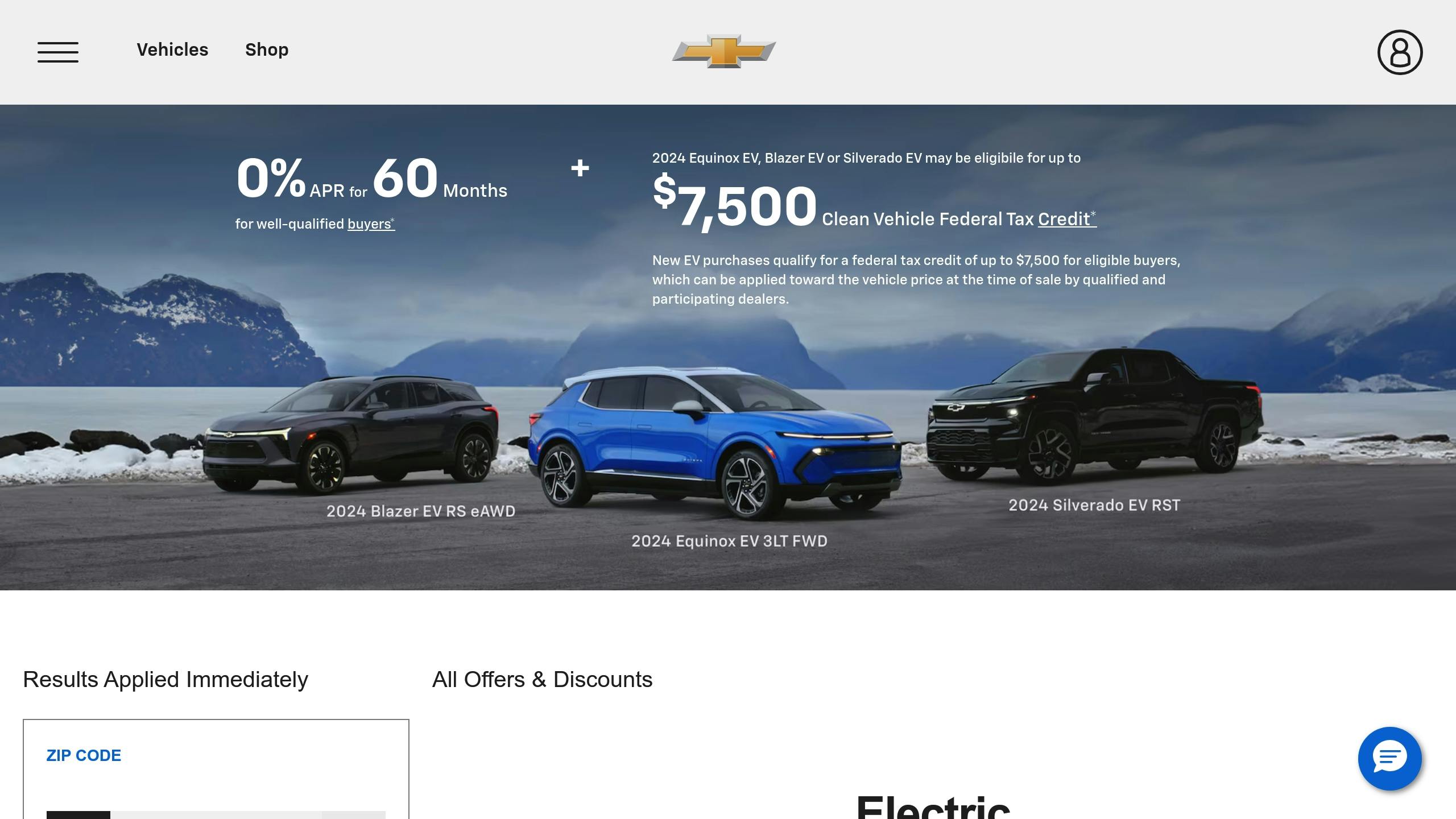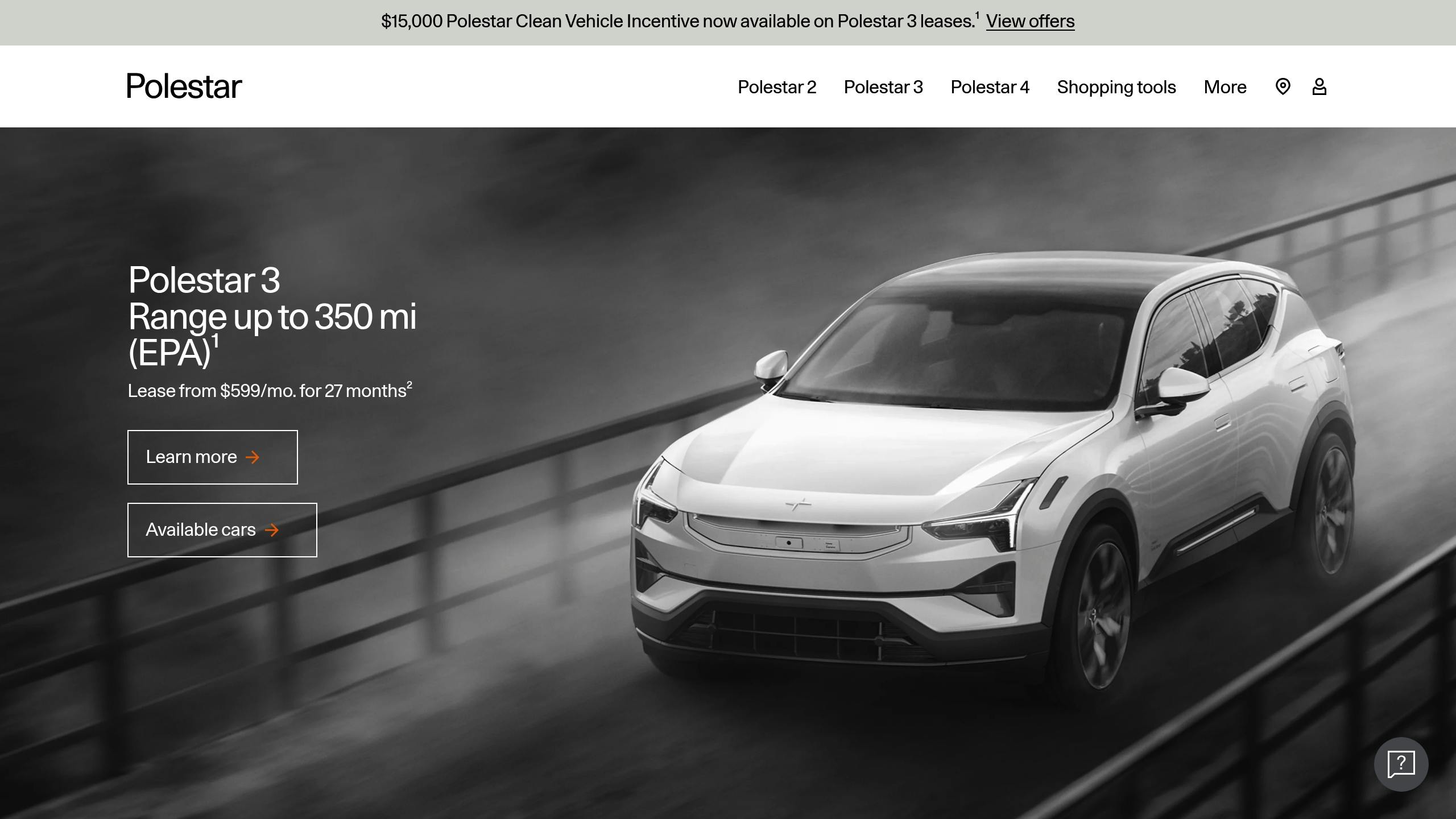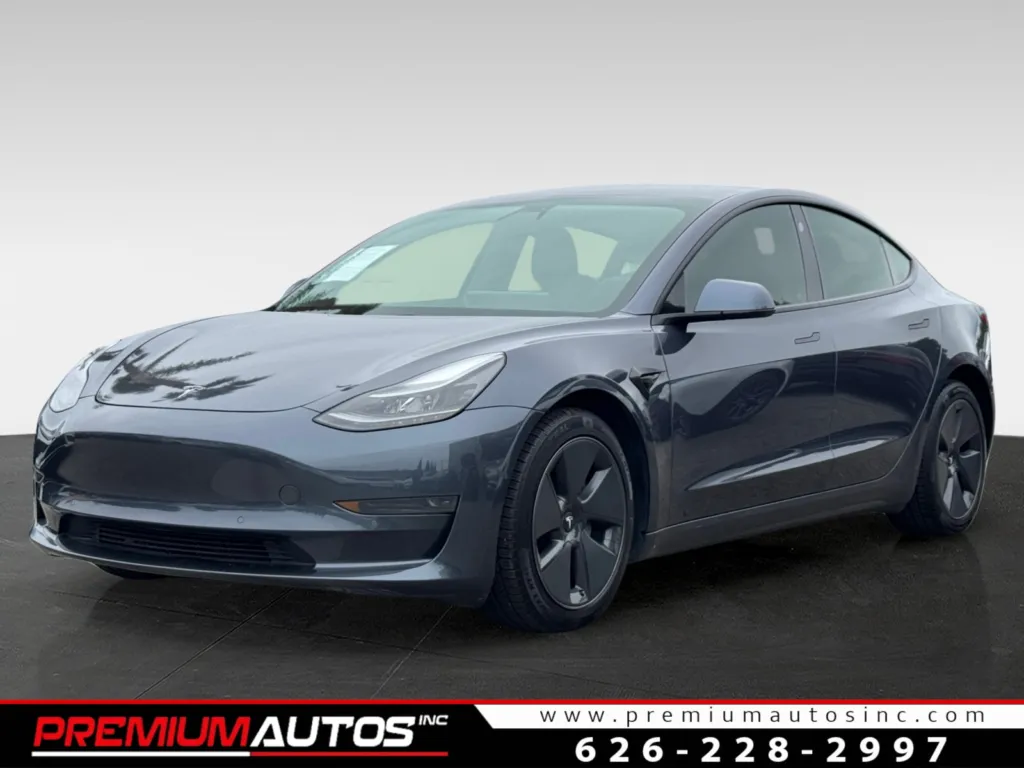7 Best Used Electric Cars Under $30,000 in 2025
7 Best Used Electric Cars Under $30,000 in 2025
By 2025, buying a used electric car under $30,000 is easier than ever. Prices have dropped due to depreciation, and these vehicles offer solid range, advanced features, and lower ownership costs. Here's a quick look at the top models:
-
Chevrolet Bolt EV (2019-2021): 259-mile range, 10.2-inch touchscreen, $20K-$25K.
-
Nissan Leaf Plus (2020-2022): 226-mile range, ProPILOT Assist, $20K-$28K.
-
Ford Mustang Mach-E Select (2021): 211-230 miles, sporty SUV, $22K-$26K.
-
Tesla Model Y Long Range (2020): 326-mile range, Tesla Supercharger access, $25K-$29K.
-
Polestar 2 Launch Edition (2021): 233 miles, Google infotainment, $25K-$30K.
-
Volvo XC40 Recharge (2021): 208 miles, luxury compact SUV, under $30K.
-
Hyundai Kona Electric (2021): 258 miles, urban-friendly, $20K-$25K.
Quick Comparison Table
| Model | Range (miles) | Price Range | Key Features |
|---|---|---|---|
| Chevrolet Bolt EV | 259 | $20K-$25K | Compact, affordable, efficient |
| Nissan Leaf Plus | 226 | $20K-$28K | ProPILOT Assist, e-Pedal |
| Ford Mustang Mach-E | 211-230 | $22K-$26K | Sporty, SUV practicality |
| Tesla Model Y | 326 | $25K-$29K | Long range, Supercharger network |
| Polestar 2 | 233 | $25K-$30K | Google-powered tech, luxury feel |
| Volvo XC40 Recharge | 208 | Under $30K | Compact luxury, fast charging |
| Hyundai Kona Electric | 258 | $20K-$25K | Urban-friendly, great efficiency |
These EVs balance range, price, and features, making them excellent choices for budget-conscious buyers in 2025. Read on for detailed specs, features, and buying tips.
Top 10 Used Electric Car Buys For 2025
1. 2019-2021 Chevrolet Bolt EV

The 2019-2021 Chevrolet Bolt EV stands out in the affordable used EV market, offering excellent range for its price. Powered by a 60 kWh lithium-ion battery, the 2020-2021 models deliver an EPA-estimated range of 259 miles[6].
| Specification | Detail |
|---|---|
| Battery Capacity | 60 kWh[6] |
| Range (2020-2021) | 259 miles[6] |
| Horsepower | 200 hp[6] |
| Torque | 266 lb-ft[6] |
| Charging Speed (DC) | Up to 55 kW[2] |
| Cargo Space | 16.9-56.6 cu ft[4] |
What else does the Bolt EV bring to the table?
-
A sleek interior with a 10.2-inch touchscreen supporting Apple CarPlay and Android Auto[2], plus flexible cargo space ranging from 16.9 to 56.6 cubic feet[4].
-
Top safety ratings, including a 5-star NHTSA score for 2019-2021 models[6], along with features like collision alerts and an optional 360-degree camera.
-
Essential driver-assist features, such as Forward Collision Alert, Lane Departure Warning, and Lane Keep Assist[2].
With an efficiency rating of 118 MPGe combined, the Bolt EV keeps running costs low. Before buying, make sure the battery recall work has been completed through Chevrolet's program[1].
2. 2020-2022 Nissan Leaf Plus

The 2020-2022 Nissan Leaf Plus offers an EPA-estimated range of 226 miles[7], powered by a 62 kWh battery and a 214-horsepower electric motor.
| Specification | Detail |
|---|---|
| Battery Capacity | 62 kWh[7] |
| EPA Range | 226 miles[7] |
| Horsepower | 214 hp[7] |
| Torque | 250 lb-ft[7] |
| Charging (DC Fast) | 0-80% in 45 min[12] |
| Efficiency | 118 MPGe combined[7] |
For those interested in driver-assist features, the ProPILOT Assist system stands out with adaptive cruise control and steering assistance. The e-Pedal feature adds convenience, allowing for one-pedal driving[4]. Inside, you'll find an 8-inch touchscreen display as part of the standard setup.
Safety features include automatic emergency braking, blind spot monitoring, and rear cross-traffic alerts. However, like the Chevy Bolt EV, this model uses the CHAdeMO fast-charging port[8], which is becoming less common. For home charging, a Level 2 charger takes about 11 hours to fully recharge the battery[2].
The Leaf Plus is backed by an 8-year/100,000-mile transferable battery warranty[8]. Maintenance costs are estimated at $300-$400 per year[3]. With pricing between $20,000-$28,000[6] and potential $4,000 tax credits[10], it’s a cost-effective option for daily driving. That said, the interior design may feel outdated compared to newer electric vehicles[12].
3. 2021 Ford Mustang Mach-E Select

The 2021 Ford Mustang Mach-E Select offers a sporty design combined with the practicality of an SUV, making it a great choice for those who want a balance of style and function. By 2025, its price ranges between $22,000 and $26,000[13]. This electric SUV is powered by a 68 kWh battery, delivering 266 horsepower and an EPA-estimated range of 230 miles for the RWD model.
| Specification | RWD Model | AWD Model |
|---|---|---|
| Range | 230 miles | 211 miles |
| Torque | 317 lb-ft | 428 lb-ft |
| 0-60 mph | 5.8 seconds | 5.2 seconds |
| Charging (DC Fast) | 10-80% in 38 minutes | 10-80% in 38 minutes |
Inside, drivers will find Ford's 15.5-inch vertical touchscreen running the SYNC 4A infotainment system, which supports wireless Apple CarPlay and Android Auto integration[1]. The SUV also offers plenty of storage, with 29.7 cubic feet of cargo space (expandable to 59.7 cubic feet) and an additional 4.8 cubic feet in the front trunk.
Safety is a key feature, with the Mach-E earning the IIHS Top Safety Pick designation. It comes equipped with the Ford Co-Pilot360 2.0 package, which includes automatic emergency braking[3]. For charging, it supports 115 kW DC fast charging (10-80% in 38 minutes) and home charging with its 10.5 kW onboard charger[1].
Though early models faced some software glitches and 12V battery issues[13], Ford addressed most of these problems through over-the-air updates. This EV stands out by offering high-end features at nearly half its original price, making it an appealing option for buyers seeking performance and value.
4. 2020 Tesla Model Y Long Range
The 2020 Tesla Model Y Long Range has become a popular choice in the used EV market, with prices in 2025 ranging from $25,000 to $29,000 [9]. While earlier options focus on affordability, the Model Y combines impressive range and Tesla's charging network - all for under $30k. This all-electric SUV boasts an EPA-estimated range of 326 miles [12][17], far surpassing rivals like the 2020 Audi e-tron (204 miles) and Jaguar I-PACE (234 miles) [2].
| Performance Metrics | Specifications |
|---|---|
| Range | 326 miles [12][17] |
| Acceleration (0-60 mph) | 4.8 seconds [12] |
| Top Speed | 135 mph |
| Cargo Space | 68 cubic feet (seats folded) [17] |
| DC Fast Charging | 162 miles in 15 minutes [6] |
One of the Model Y's key advantages is its access to Tesla's Supercharger network, which includes over 45,000 stations worldwide as of 2025 [6]. At V3 Supercharger stations, the car can gain 162 miles of range in just 15 minutes [6], making road trips much easier.
Inside, the Model Y reflects Tesla's sleek and simple design, centered around a 15-inch touchscreen that handles nearly all vehicle functions [17]. While the interface is user-friendly, it does lack support for Apple CarPlay and Android Auto.
The Model Y also stands out for its practicality. Maintenance costs are lower compared to gas-powered luxury SUVs. Standard Autopilot features like Traffic-Aware Cruise Control and Autosteer [5] add convenience, and the optional Full Self-Driving package offers even more advanced capabilities.
Cold weather can reduce the range by 30-40% when temperatures dip below 20°F, but features like battery preconditioning and an efficient heat pump help minimize daily disruptions [8].
For those considering a used Model Y, it's worth checking for common issues such as body panel alignment and paint quality [10]. Thankfully, Tesla's software updates have addressed most early concerns [17].
sbb-itb-66f4901
5. 2021 Polestar 2 Launch Edition

The 2021 Polestar 2 Launch Edition blends Scandinavian luxury with a tech-focused approach, following in Tesla's footsteps. Its dual-motor all-wheel-drive system delivers an impressive 408 horsepower and 487 lb-ft of torque[6], enabling a quick 0-60 mph sprint in just 4.5 seconds[6]. All this comes at a price point under $30,000[6].
| Key Specifications | Details |
|---|---|
| Battery Capacity | 78 kWh[6] |
| EPA Range | 233 miles[6] |
| DC Fast Charging | Up to 150 kW[19] |
| Charging Time (10-80%) | 40 minutes at 150 kW[19] |
| Power Output | 408 hp / 487 lb-ft[6] |
| Cargo Space | 38.7 cu ft (seats folded)[3] |
Although the 233-mile range is shorter than some competitors[6], the Polestar 2 makes up for it with high-quality construction and sporty handling. It supports Level 2 charging (around 8 hours for a full charge) and 150 kW DC fast charging, which takes just 40 minutes to go from 10% to 80%[1][19]. The hatchback design provides 14.3 cu ft of cargo space, expandable to 38.7 cu ft with the seats folded, plus a small 1.2 cu ft frunk for extra storage[3].
Inside, the cabin showcases a clean, minimalist design with vegan upholstery[18] and a Google-powered infotainment system[8]. The 11.15-inch touchscreen offers seamless integration with Google Maps, Assistant, and the Play Store[3].
Safety is a priority, with features like Pilot Assist, adaptive cruise control, a 360-degree camera, and eight airbags, including knee protection[1][3].
Additional touches like the Harman Kardon premium audio system, a panoramic glass roof[18], and sport-tuned suspension[6] enhance the driving experience, making the Polestar 2 a well-rounded and appealing premium EV option.
6. 2021 Volvo XC40 Recharge

The 2021 Volvo XC40 Recharge brings Polestar's tech-forward luxury into a compact SUV, now available for under $30,000 with federal tax credits for used EVs [14]. It offers a great entry point into Volvo's EV lineup while maintaining the brand's focus on safety and performance. This all-electric SUV features a dual-motor system delivering 402 horsepower and 486 lb-ft of torque, ensuring a powerful yet smooth driving experience [1].
| Key Specifications | Details |
|---|---|
| EPA Range | 208 miles [7] |
| Charging Time (0-80%) | 40 minutes [20] |
| Power Output | 402 hp / 486 lb-ft [1] |
| Cargo Space | 47.4 cu ft maximum [1] |
With a 0-60 mph time of just 4.7 seconds [7], the XC40 Recharge is quick off the line, offering thrilling acceleration. While its 208-mile range may not top the charts [1], the fast-charging capability - reaching 0-80% in just 40 minutes [20] - helps make up for it.
Inside, Volvo combines luxury and cutting-edge technology. The cabin features a 12.3-inch digital driver display and a 9-inch touchscreen running Google Android Automotive OS [1][5]. For storage, it offers 17.7 cubic feet behind the rear seats, expanding to 47.4 cubic feet when the seats are folded down [1].
Maintenance is straightforward and cost-effective, thanks to the electric powertrain. Routine upkeep generally involves tire rotations and brake fluid checks.
The XC40 Recharge also includes advanced driver assistance systems, such as semi-autonomous driving features [20]. Other standard perks include wireless smartphone charging and a panoramic sunroof [1][5], making it a strong contender in the used luxury EV market.
7. 2021 Hyundai Kona Electric

For city dwellers looking for an EV that balances cost and range, the 2021 Hyundai Kona Electric stands out with its 258-mile range per charge [7]. Priced between $20,000 and $25,000 [21], this compact crossover offers better range than competitors like the Nissan Leaf Plus, all while maintaining a size perfect for urban driving.
| Key Specifications | Details |
|---|---|
| Battery Capacity | 64 kWh lithium-ion polymer [7] |
| EPA Range | 258 miles [7] |
| Power Output | 201 hp / 291 lb-ft torque [7] |
| Charging Time (10-80%) | 47 minutes (100 kW DC) [2] |
| Cargo Space | 19.2 cu ft (45.8 max) [5] |
The Kona Electric's 64 kWh battery provides a solid 258-mile range [7] and delivers quick acceleration with 201 hp, going from 0 to 60 mph in just 6.4 seconds [15]. It supports CCS fast charging, allowing a 10-80% charge in 47 minutes using a 100 kW DC charger. For home charging, the 7.2 kW onboard charger handles overnight Level 2 charging with ease [1][2].
Inside, the Kona Electric comes equipped with a standard 8-inch touchscreen featuring smartphone integration, with an option to upgrade to a 10.25-inch display in higher trims [3]. Safety features include Hyundai's SmartSense suite, which offers blind-spot monitoring and collision avoidance [7].
The vehicle also includes a 10-year/100,000-mile transferable warranty for the battery and powertrain [16]. With 19.2 cubic feet of cargo space behind the rear seats [5], the Kona Electric secures its place as a practical and budget-friendly EV under $30,000.
EV Specs and Features Comparison
Here's a breakdown of the key differences between our seven selected electric vehicles:
| Model | Range (miles) | DC Fast Charging | Standout Tech |
|---|---|---|---|
| 2020 Tesla Model Y LR | 326 | 250 kW | Autopilot, 15" touchscreen |
| 2019-21 Chevrolet Bolt EV | 259 | 55 kW | One-pedal driving, 10.2" display |
| 2020-22 Nissan Leaf Plus | 226 | 50 kW | ProPilot Assist, e-Pedal system |
| 2021 Ford Mach-E Select | 211-230 | 150 kW | Co-Pilot360, 15.5" screen |
| 2021 Polestar 2 | 233 | 150 kW | Google-based infotainment |
| 2021 Volvo XC40 | 208 | 150 kW | Pilot Assist, safety-focused |
| 2021 Hyundai Kona | 258 | 75 kW | SmartSense suite |
Key Differences
-
Range: The 2020 Tesla Model Y Long Range leads the pack with a range of 326 miles. For lower price points, the Hyundai Kona Electric and Chevrolet Bolt EV still offer impressive ranges exceeding 250 miles [6].
-
Charging and Road Trips: Tesla's Supercharger network gives the Model Y a clear edge for long-distance travel [12].
-
Software Updates: Tesla stands out with its frequent over-the-air updates, keeping the vehicle fresh and functional over time. Other models, like the Ford Mach-E and Polestar 2, also support updates, which can help maintain resale value. Older models, however, often have limited upgrade paths [10][15].
Final Buying Tips
Now that you have a list of top models, let’s focus on some key steps to get the most for your money:
Check Battery Health
Ask for a detailed battery health report that shows how much capacity remains. During your test drive, compare the actual range to the original specifications [1][4].
Evaluate Charging Options
Look into charging availability along your regular routes using tools like PlugShare or ChargePoint. Tesla owners can take advantage of the Supercharger network, while other brands rely on third-party chargers that can vary in dependability [2].
Hidden Costs to Keep in Mind
| Cost Category | Typical Range | Notes |
|---|---|---|
| Home Charger Installation | $500-$2,000 | Depends on your home’s electrical setup [2] |
| Battery Replacement | $5,000-$15,000 | Rare but important for long-term planning |
| Specialized Maintenance | EV-certified only | Limited number of service centers |
| Insurance Premiums | 15-25% higher | Reflects the advanced technology involved |
Review Warranty Details
Confirm how much time remains on the battery warranty, which is usually valid for 8-10 years from the original purchase date [1][4].
Look Into Tax Credits
Used electric vehicles priced under $25,000 may qualify for federal tax credits up to $4,000 or 30% of the sale price, whichever is less [11].
Get a Professional Inspection
Hire an EV-specific mechanic to check:
-
Battery health
-
Charging functionality
-
Drive unit performance
-
Software update history
This step is especially important for high-mileage models like Teslas and Ford Mach-Es, as their battery systems are more complex.
Gather Documentation
Ensure you have the full service history and proof of recall compliance.
For peace of mind, prioritize models with updated battery management systems, such as the 2021 Kona Electric or post-recall Bolt EV.
FAQs
How much will a Tesla Model 3 cost in the future?
The starting price for the 2025 Tesla Model 3 is set at $44,130 for the base model, with higher trims reaching up to $56,630[12]. While these prices are above the $30,000 mark, buyers looking for Tesla's features at a lower cost might consider our #4 pick, the 2020 Model Y, or wait for a larger selection of used Model 3s in 2025.
Here are some key factors that could impact future Model 3 pricing:
| Factor | Impact on Price |
|---|---|
| Production Costs | Tesla aims to cut production costs by 50%[7] |
| Battery Technology | Adoption of LFP batteries reduces costs[10] |
| Market Competition | More options push prices to stay competitive |
| Government Incentives | Federal and state programs influence pricing |
If you're considering a used Model 3, late 2025 could be a smart time to buy. By then, more lease returns will hit the market, and advancements in battery technology may further lower costs[10]. As of 2023, the average used Model 3 price had already dropped 21%, settling around $41,000[6].
When evaluating a used Tesla Model 3, think beyond the purchase price. Tesla ownership often comes with perks like strong resale value and access to over 45,000 Superchargers worldwide[6]. These benefits can make the total cost of ownership more appealing compared to other EVs.
For those sticking to a $30,000 budget, check out our top picks (#1–#7) for affordable options that still deliver great electric driving experiences.











